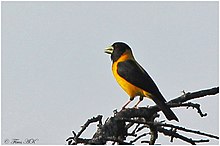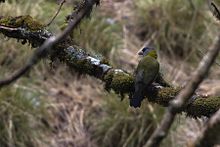Collared grosbeak
| Collared grosbeak | |
|---|---|

| |
| Male | |

| |
| Female | |
| Scientific classification | |
| Domain: | Eukaryota |
| Kingdom: | Animalia |
| Phylum: | Chordata |
| Class: | Aves |
| Order: | Passeriformes |
| Family: | Fringillidae |
| Subfamily: | Carduelinae |
| Genus: | Mycerobas |
| Species: | M. affinis
|
| Binomial name | |
| Mycerobas affinis (Blyth, 1855)
| |
The collared grosbeak (Mycerobas affinis) is a species of
Description
The collared grosbeak may be the largest species in the diverse

The flight call of this bird is a mellow but rapid Pip-pip-pip-pip-uh. It is also known to utter a sharp alarm call, kurr. The male's song is a clear, loud and rising whistle consisting of five to six notes. The grosbeaks may utter a creaky groan in antagonistic interactions.
Ecology
The collared grosbeak ranges from fairly common to scarce within its range. The species summers and breeds at an elevation of 2,700 to 4,200 m (8,900 to 13,800 ft). It engages in altitudinal movements, by winter traveling to as low as 1,800 m (5,900 ft) or even to 1,060 m (3,480 ft). This grosbeak occurs in mixed and coniferous forests, commonly around stands of
References
- Finches and Sparrows by Peter Clement. Princeton University Press (1999). ISBN 978-0691048789.
- . Retrieved 11 November 2021.
- ^ Birds of South-East Asia (Field Guide to) by Craig Robson. New Holland Field Guides.
- ISBN 978-0-8493-4258-5.

